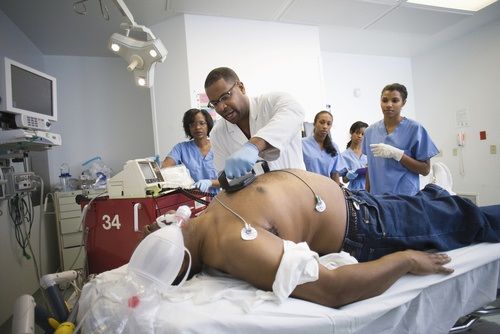EDs that Treat Many Atrial Fibrillation Cases Have Better Outcomes
Emergency departments' experience matters in treating atrial fibrillation.

An analysis of Canadian patient data has found that people who sought emergency care for atrial fibrillation (AF) or atrial flutter were less likely to require hospital admission or a second emergency room visit when they received their initial treatment at emergency departments that handle many cases of AF.
Investigators tracked all 43,372 instances of patients aged 35 years or older seeking care for AF or atrial flutter from any of the 104 emergency departments in Alberta between 1999 and 2011. The investigators compared outcome data for cases treated in the province’s 11 high-volume emergency departments (those that treated 100 or more cases a year) and for cases treated in its 93 low-volume emergency departments.
Treatment at high-volume emergency departments was associated with lower rates of hospital admission (adjusted odds ratio [OR], 0.68; 95% confidence interval [CI], 0.64-0.72; p<0.001) and fewer returns to the emergency department within 90 days (OR, 0.81; 95% CI, 0.73-0.90; P<0.001).
Treatment at high-volume emergency departments was also associated with a greater likelihood of patients following up with specialists in both a 30-day period (OR, 1.81; 95% CI, 1.68-1.94; p<0.001) and a 90-day period (OR, 1.82; 95% CI, 1.76-2.03; p<0.001).
Even among patients who were admitted to the hospital after seeking emergency care, treatment at high-volume emergency departments was associated with fewer subsequent emergency department visits both in the next 30 days (OR, 0.37; 95% CI, 0.15-0.87; p= 0.02) and in the next 90 days (OR, 0.48; 95% CI, 0.26-0.89; p= 0.02).
There was, however, no difference in death rates between patients who sought care at high-volume and low-volume emergency departments.
“In the emergency department, higher volumes have been associated with lower in-hospital death in multiple conditions (e.g., pneumonia, heart failure, sepsis, stroke, respiratory failure, gastrointestinal hemorrhage and renal failure),” the study authors wrote in PLOS One. “Using a comprehensive, reliable, population-based database for emergency department presentations, we identified familiarity based on the volume of patients seen annually as a factor to explain some of the practice variation observed in Alberta emergency departments with respect to the outcomes of patients with primary atrial fibrillation or flutter.”
The authors of the new study believe they are the first to explore the relationship between emergency department volume and outcomes in patients with atrial fibrillation and flutter. That said, they noted that many previous studies have found that greater experience treating a particular condition often leads to better outcomes.
The authors of the new study could not say exactly how AF care varied from high-volume to low-volume emergency departments, or even that it did vary. The databases mined for the study capture few details about case severity or treatment specifics. There are, of course, very specific guidelines for the treatment of AF, which theoretically should insure similar care everywhere, but the authors of the new study noted that previous research has found significant variation in real-world treatment patterns.
“For example,” they wrote, “rate control practices, decisions regarding prompt cardioversion (chemical vs electrical), specialist referrals and follow-up time vary according to age, sex, socio-economic status, location and hospital setting (e.g., rural vs urban). Emergency department management and follow-up vary, and outcomes could be improved.”